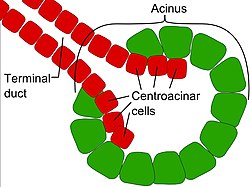
Back Eksokriene stelsel Afrikaans غدة خارجية الإفراز Arabic Xarici sekresiya vəziləri Azerbaijani বহিঃক্ষরা গ্রন্থি Bengali/Bangla Egzokrina žlijezda BS Glàndula exocrina Catalan ڕژێنی جۆگەدار CKB Soustava žláz s vnější sekrecí Czech Exokrine Drüse German Ekzokrina glando Esperanto
| Exocrine gland | |
|---|---|
 | |
| Details | |
| Identifiers | |
| Latin | glandula exocrina |
| MeSH | D005088 |
| TH | H2.00.02.0.03014 |
| FMA | 9596 |
| Anatomical terminology | |
Exocrine glands are glands that secrete substances onto an epithelial surface by way of a duct.[1] Examples of exocrine glands include sweat, salivary, mammary, ceruminous, lacrimal, sebaceous, prostate and mucous. Exocrine glands are one of two types of glands in the human body, the other being endocrine glands, which secrete their products directly into the bloodstream. The liver and pancreas are both exocrine and endocrine glands; they are exocrine glands because they secrete products—bile and pancreatic juice—into the gastrointestinal tract through a series of ducts, and endocrine because they secrete other substances directly into the bloodstream. Exocrine sweat glands are part of the integumentary system; they have eccrine and apocrine types.
- ^ Young, Barbara; O'Dowd, Geraldine; Woodford, Phillip (2013). Wheater's Functional Histology: A Text and Colour Atlas (Sixth ed.). Elsevier. p. 95. ISBN 978-0702047473. LCCN 2013036824.
© MMXXIII Rich X Search. We shall prevail. All rights reserved. Rich X Search